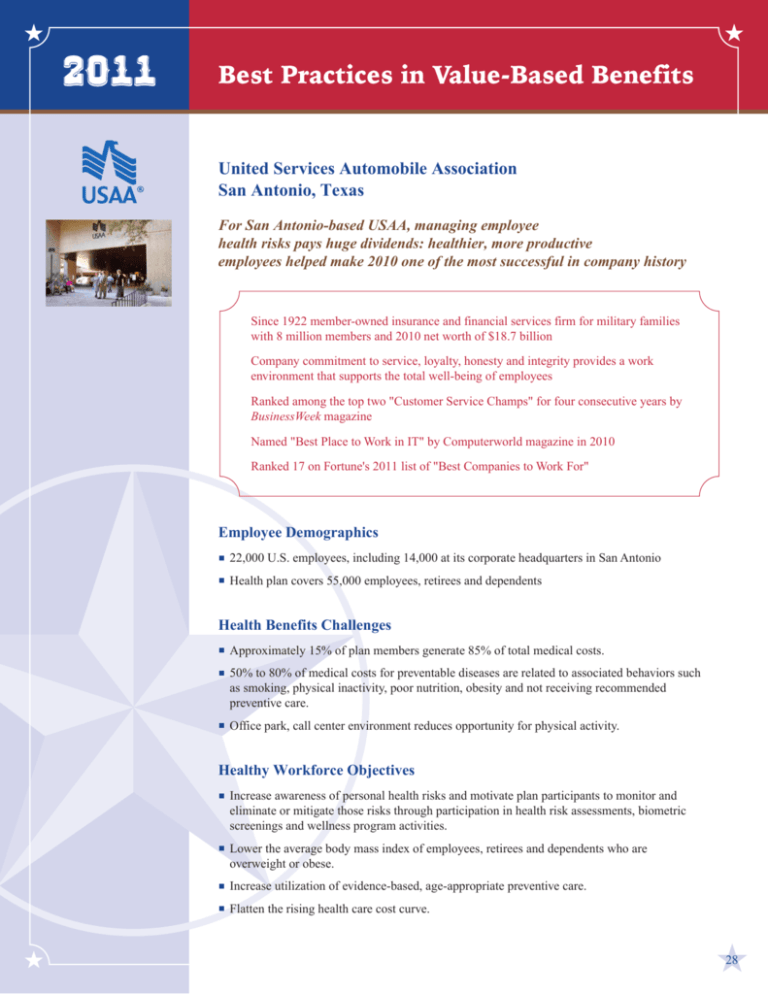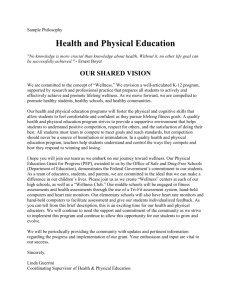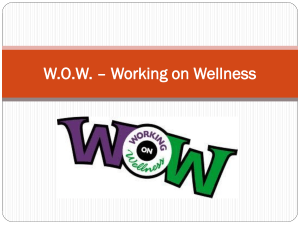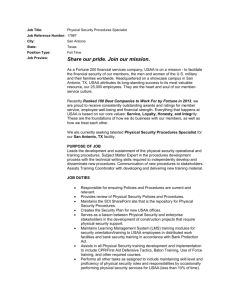United Services Automobile Association San Antonio, Texas
advertisement

United Services Automobile Association San Antonio, Texas For San Antonio-based USAA, managing employee health risks pays huge dividends: healthier, more productive employees helped make 2010 one of the most successful in company history Since 1922 member-owned insurance and financial services firm for military families with 8 million members and 2010 net worth of $18.7 billion Company commitment to service, loyalty, honesty and integrity provides a work environment that supports the total well-being of employees Ranked among the top two "Customer Service Champs" for four consecutive years by BusinessWeek magazine Named "Best Place to Work in IT" by Computerworld magazine in 2010 Ranked 17 on Fortune's 2011 list of "Best Companies to Work For" Employee Demographics 22,000 U.S. employees, including 14,000 at its corporate headquarters in San Antonio Health plan covers 55,000 employees, retirees and dependents Health Benefits Challenges Approximately 15% of plan members generate 85% of total medical costs. 50% to 80% of medical costs for preventable diseases are related to associated behaviors such as smoking, physical inactivity, poor nutrition, obesity and not receiving recommended preventive care. Office park, call center environment reduces opportunity for physical activity. Healthy Workforce Objectives Increase awareness of personal health risks and motivate plan participants to monitor and eliminate or mitigate those risks through participation in health risk assessments, biometric screenings and wellness program activities. Lower the average body mass index of employees, retirees and dependents who are overweight or obese. Increase utilization of evidence-based, age-appropriate preventive care. Flatten the rising health care cost curve. 28 Value-based Benefits and Wellness Strategies Implement a multidimensional 'Take Care of Your Health' wellness program that allows employee participants to earn "Healthy Points" to be applied toward health plan premiums—up to $300 for individuals and up to $900 for families. Adopt clear and actionable wellness messages: Don't Smoke, Be Active, Eat Right, Prevention. Require all employees and spouses to complete health risk assessments and biometric screenings to become eligible for wellness benefits and financial incentives. Eliminate copayments for prescription smoking medications and provide $300 to help employees stop smoking and lose weight. Create a fifth tier on the prescription drug formulary for preventive drugs, lowering copayments below that of generics to $3 for one-month and $6 for three-months. Promote consumption of healthy foods in the company cafeteria and in vending machines by making them more visually prominent and lowering their prices. Provide on-site pharmacy, Weight Watchers programs and state-of-the-art fitness centers. Institute a smoke-free campus to discourage the use of tobacco. Outcomes Impact of Higher Body Mass Index (BMI) on Medical Costs Winner of the 2006 C. Everett Koop National Health Award, one of the most prestigious national awards for health and wellness programs. Measurable decrease in average employee body mass index in 2010 (reduction from 29.2 to 28.7) following a five-year upward BMI trend. USAA wellness program logo $5K Medical Cost More than 85% of employees regularly participate in wellness programs. $5,744 $6K $4K $4,601 $3,601 $3,813 <24.9 25-29.9 30-34.9 BMI $3K $2K $1K 0 Employee tobacco use has dropped to just 7-8%. >35 Achieved a five-year average health care cost trend of just 2% for employees, 5.5% for dependents. Nearly 100% of employees have completed at least one annual health risk assessment. Next Steps Work toward reducing the health care cost trend for adult dependents. Develop a tool-kit and share best practices with other employers to improve the overall health of the community. Work with other employers to create financial incentives to encourage providers to practice evidence-based medicine. Achieve 100% completion of health risk assessments and biometric screenings. Work toward 'Healthy People 2020' population goals. On the Road to Value As a company recognized for its legendary customer service, San Antonio-based United States Automobile Association has long recognized that its employees are its greatest asset. Like many companies approaching the new Millennium, USAA faced the reality of spiking healthcare costs, growing disability claims and expanding employee waistlines. A fresh focus on health and wellness was needed. USAA began to put more focus on wellness in 2003 with the introduction of a new multifaceted, holistic wellness program designed to make wellness an integral part of USAA's culture and to create an environment for employees that promotes and supports healthy living. "Take Care" branding that focused on physical, mental and financial health reinforced the commitment to a culture of wellness based on individual empowerment. The objective of USAA's wellness program is "to remove barriers and obstacles to employees focusing on member service, things that could distract employees from being able to pay attention," Dr. Peter Wald, VP and Enterprise Medical Director, explained. "If employees are physically, financially and emotionally healthy, that translates into improved member experience." In 2009, USAA added a points-based program that allows employees to earn "Healthy Points" by participating in a variety of health and wellness activities. When an employee reaches a specified point goal, he or she earns a medical premium reduction. In 2011, employees can earn a 5% reduction in their 2012 medical premiums when they earn 1,000 points between Jan. 1 and Nov. 30 —a savings of between $300 and $900, depending on the level of coverage. The program's entry point is completion of an on-site or online health risk assessment. Participants have a variety of ways to earn points, such as working out at the company's onsite fitness center, eating healthy foods in the company cafeteria or participating in community running events and weight loss competitions. Today more than 85% of USAA's employees participate in some part of the wellness program, which includes more than 20 wellness initiatives and activities. USAA 2006 winner of C. Everett Koop National Health Award The program, which won the C. Everett Koop National Health Award in 2006, has effectively led to reductions in employees' average BMI in 2010, reversing a five-year upward trend. In addition, tobacco use rates have remained between 7% and 8%, while the company's annual health care cost trend have tapered off to 2% for employees and 5.5% for dependents. "Take Care" Outcomes: Winner of the 2006 C. Everett Koop National Health Award 85+% of employees participate in wellness programs Decrease in average employee BMI Employee tobacco use just 7-8% 5-year average health care cost trend of 2% for employees, 5.5% for dependents Nearly 100% of employees have completed an HRA Does focusing on wellness work? It certainly hasn't hurt USAA, where they've seen their financial performance mirror their successes on the health and wellness front. At a time when many U.S. employers are struggling, 2010 proved to be the best in the USAA's 88-year history. The company's revenues surged to $18 billion in 2010, up from $17.6 billion in 2009. USAA's net worth also grew to $18.7 billion, up from $17 billion in 2009. On the Road to Value (continued) USAA plans to continue to widen the reach of its wellness program. Because the rate of dependent health care cost increases continues to outpace that of employees, USAA is working to expand its "Take Care of Your Health" program into employees' homes, targeting adult dependents first, then children. In addition, USAA is collaborating with the San Antonio Metropolitan Health District to launch a business coalition that will encourage other employers in the area to adopt similar wellness programs designed to improve the health of the entire community. "We try to be the employer of choice in every city where we operate. Therefore, it's very important for us to help the community to be healthier, because it's so hard to change employees' habits once they get here," Dr. Wald said. Moreover, "we always share what we're doing here because we think that it's important to try and move the ball down the field." Dr. Peter Wald USAA "We've been working hard to provide our employees a work environment that promotes and supports a healthy lifestyle. We have nutrition information in cafeterias and offer healthy foods there and in our vending machines at decreased prices. There are mileage markers on our service level as part of our walking program and digital billboards throughout the building continuously displaying wellness content." Dr. Peter Wald, Vice President and Enterprise Medical Director, USAA 31











